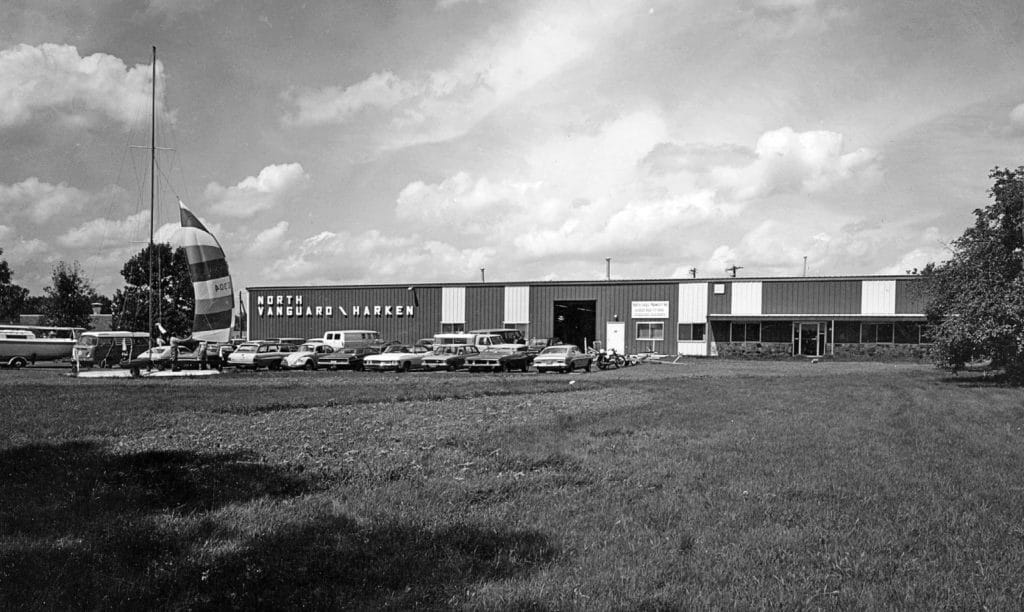
It’s the mid-1970s. In a small boatbuilding shop, college student Michael Loeb is hunched over a workbench, dissecting a small ball-bearing block and placing BB-size Torlon balls in a pile off to one side. Next to those are a half-dozen other piles of ball bearings. He meticulously weighs each pile, intent on figuring out which group of 20 ball bearings weighs the least.
When the morning shift arrives, workers discover Loeb and Steve Cucchiaro, both bedraggled, huddled at the bow of their 470 dinghy. Alongside them are spreadsheets, a few tools, and empty beer cans. They’ve spent the night focusing on the slotted screw heads that hold fittings onto the deck. On the starboard side, the slots align with where the apparent wind direction on starboard tack. On the port side, the slots face where the apparent wind would come on port tack.
The obsession with such detail is simple. The Olympics — Kingston, Ontario, in 1976 and then Tallinn, Russia, in 1980 — have captured the focus of the top young guns of the sailing world, so much so that no screw is too small to turn. Or maybe it was simply the type of boat work that Steve Taylor, an accomplished 470, 420, 505 and Flying Dutchman sailor of that era, now calls “juvenile fanaticism.”
While perhaps excessive and atypical of those answering the call of the Olympics, such attention to detail had a lot to do with why U.S. 470 and Finn sailors of the era dominated world competition for more than a decade, says Taylor, amassing Olympic medals, European championships, world championships, and virtually every North American and national title.
But something else was at play — a common denominator, you might say. From the 1970s through the 1980s, the orbits of the Olympic 470 and Finn classes somehow touched Vanguard Boats, then just a small, pre-fab metal structure in the flatlands of rural Pewaukee, Wisconsin. Circumstances once aligned in such a way that the scene became unlike any today, an explosive combination of innovative entrepreneurs, talented craftsmen and a bunch of obsessive young dinghy sailors.
“There were a slew of people, all trying new ideas,” says Loeb, who built a Flying Dutchman on the premises. “Peter and Olaf Harken were really receptive to young people coming in.”
Steve Benjamin, Olympic 470 silver medalist in 1984, built nearly 10 boats there in the 1970s. “It was a pretty unique time, where you had a manufacturer who was willing to let the sailors in and work together with them,” says Benjamin. “It was pretty special.” “It disrupted production like hell, but that was where we got our good ideas — from these guys,” says Peter Harken, who along with his brother, Olaf, owned not only Harken Inc. but Vanguard as well. “Making our boats the best in the world, that wasn’t coming from us. We didn’t know every little nuance and everything going [on], but these guys did. So we let them work on their own boats, and then we took the best of each one and employed that in every new boat we were building.”
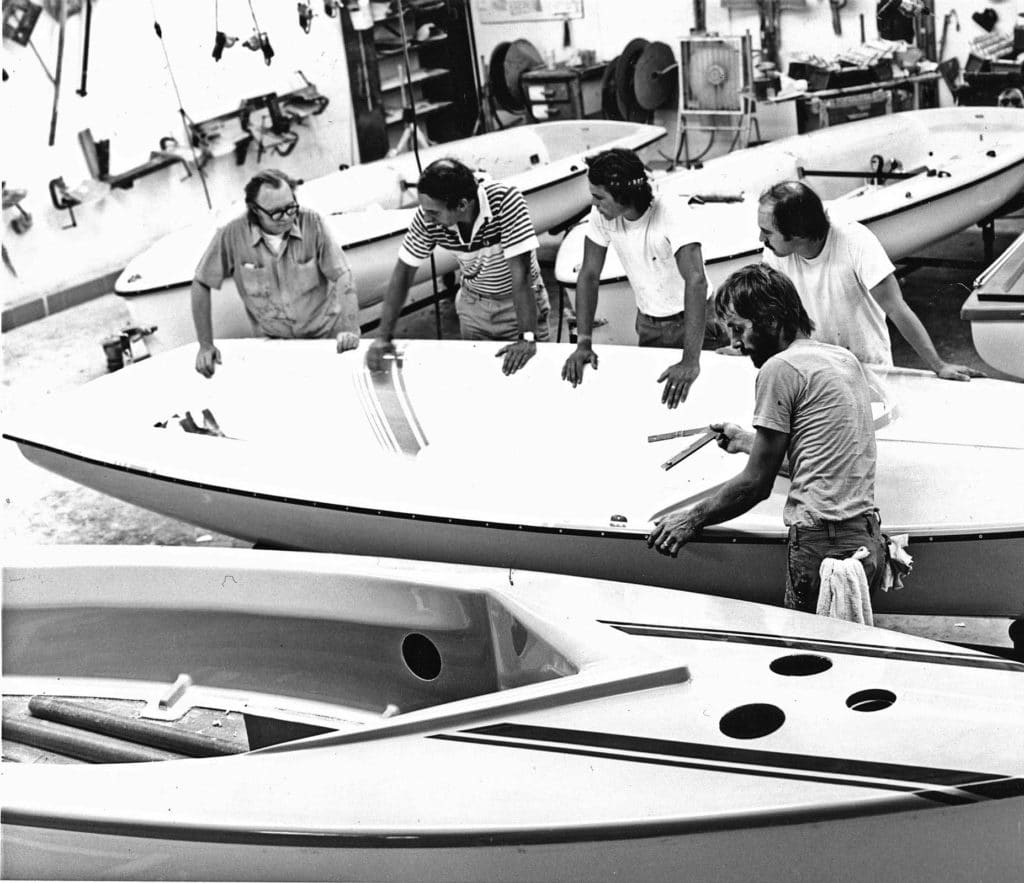
There were plenty of opportunities. Chuck Millican, who worked for Vanguard from 1972 to 1977 and also campaigned a 470, describes the process. “We moved bulkheads around a little bit, within the class rules, but if you had a strong boat from stem fitting to mast step, chainplates to mast step, and then chainplate to chainplate, you could almost have a paper shell outside of everything else,” he says. “The whole key was to make that happen.” A lot of what they did to accomplish such weight savings required hours more labor than possible in production. Finn hulls didn’t experience the same rig-tension forces as the 470, but there were areas yet to be considered. Word spread quickly, and Vanguard emerged as the hub for anyone aspiring to sail 470s and Finns on the world stage. Finn sailor Peter Conrad was one of those.
“It really was the upper echelon of the one-design sailing fraternity,” says Conrad. “We built boats by day, and at night we went to this place on the lake called the Lakeaires, and the talk and the culture and the mentality was all about which boats won in the Olympics and who was using them. It was about as intense as it can get.” Those not in Pewaukee already were probably working on a plan to get there. Taylor remembers back-to-back 470 regattas in 1975 — the Midwinters and an Olympic training regatta — and being in “a really fierce, competitive battle” with Mark Ploch. “When it was over,” he says, “the first thing we did was get in our vehicles and drive straight through to Pewaukee, through ice storms and all, to build the next boat.” It wasn’t only North American sailors who made the trek. Olaf recalls that in 1974, a group of Japanese sailors arrived in Pewaukee to pick up six new 470s, but they didn’t speak any English. Their plan was to sail the boats at Association Island, in upstate New York, which was the U.S. Olympic training center for several years before the 1976 Olympics. “They wanted to drive there, but they had no concept of distance in this country,” says Olaf. “They couldn’t even read any signs.” So Olaf and his wife, Ruthie, loaded the team’s boats on a trailer and drove them 13-plus hours to Association Island. “It was a pretty big order,” Olaf says. “We had to take care of it.”
While some sailors swung through Pewaukee to pick up new boats, others came for more direct involvement. “A few of the guys spent just two weeks there, some wanted to be there from the minute their boat was sprayed, and some came out when the boat was just out of the mold to put the fittings on,” says Millican. Typically, there would be three or four of them at a time. Then there were Cucchiaro and Loeb. “We showed up sometime in mid- to late September,” says Cucchiaro. “They finally told us we had to leave right before Christmas. We lived through every inch of that boat’s construction.” It paid off for them when they won the biggest regatta before the Olympic Trials, in Miami, where they handily beat a field of 81 boats. They ended up a disappointing fourth in the 1976 Olympic Trials the following June, however Cucchiaro went on to win the 1978 470 Nationals and a gold medal in the 470 at the 1979 Pan American Games.
Many of those who journeyed to Vanguard were either at the end of their college careers or fresh out of school. “They were chasing races around on a dime and a dollar, living in crappy old vans and going from top regatta to top regatta, working their way up to being world-class sailors,” says Peter Harken. Terry Neilson, who campaigned three Vanguard Finns and won a bronze medal for Canada in one of them, says: “I was parked there for around three or four days and slept in my van until Peter finally said, ‘Come and stay at my place.’ I was there enough and all over the place that I think a few of them thought I was an employee.”
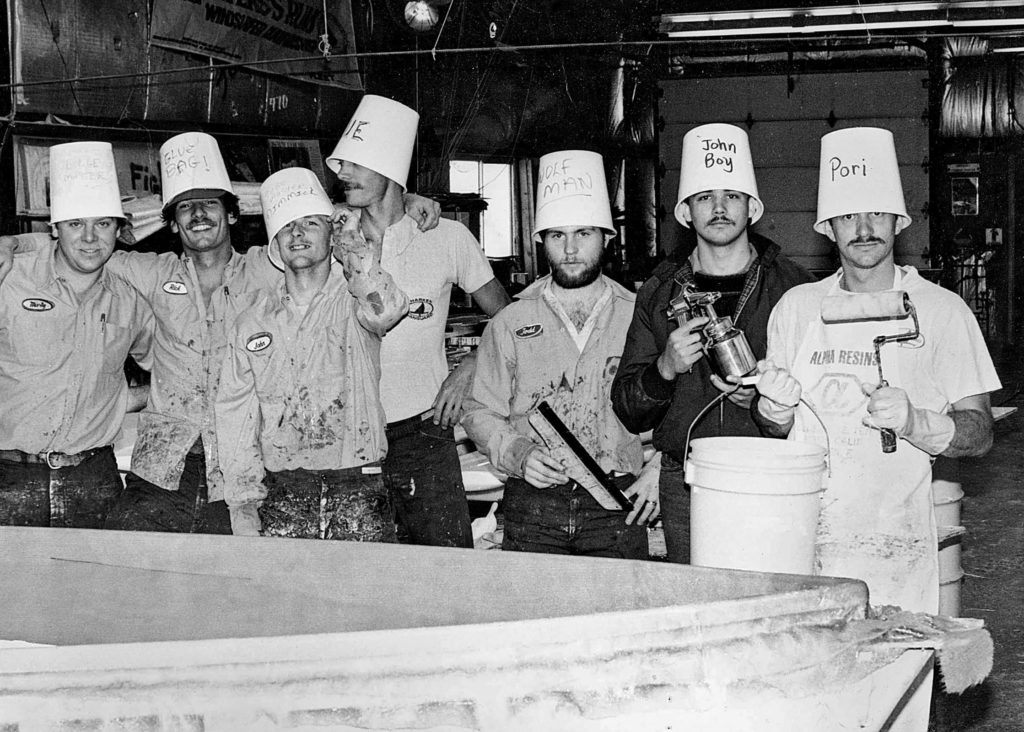
Vanguard started in 1967. “My brother and I both gave up very good job opportunities, which really pissed my father off,” says Peter. “He couldn’t believe it, especially when we told him what we wanted to do — to create a boat company from scratch.”
Early on, they built Badger Tech dinghies for the University of Wisconsin, Madison, and Club Flying Juniors for collegiate programs. Then their company took a giant leap in quality. “Olaf and I were working in our Waukesha shop, along with Tony Shinners, doing everything ourselves until 3 or 4 in the morning and kind of looking for some help, when Bob Grammins and Don Michelson showed up on our doorstep. We said, ‘We’d love to have you, but we don’t think we could afford any more than $5 an hour.’ And they said: ‘Well, that is quite a lot less than we can afford to do, but I’ll tell you what. You guys let us just build a hull for you, and if you like it, we’ll stay; we’ll work at $5 an hour, and you just bring in the beer at the end of the day.’ These guys were poetry in motion, the way they did the glass and everything. Olaf and I were just standing there with our mouths hanging open and said, ‘Holy Christ, are they good!’”
Both were hired. Around that same time, the International Yacht Racing Union (now World Sailing) was working on selecting a two-man dinghy for the 1976 Olympics, and it came down to the Fireball, a German dinghy called a Strale, and the 470. The Harkens bet on the 470, produced their first boat in 1969, and went into full production in 1970, the same year they moved into their new facility on East Wisconsin Avenue in Pewaukee. When IYRU selected the 470, late in 1972, Vanguard was in the catbird seat. “We were the first builders in the United States,” says Peter, “and luckily, the Olympic committee chose it, and that got us going on our way.” Being the only Olympic 470 builder in the States gave them the edge. “In those days, you didn’t buy a lot of stuff internationally,” says Conrad. “There just wasn’t the ability to make those kinds of transactions.”
In 1974, Vanguard fell on hard times and production ground to a halt. Instead of folding, they looked to other classes, adding two versions of the 420, a boat designed to be a steppingstone to the 470. The collegiate model took off, with Yale ordering the first large fleet and the U.S. Naval Academy the next. Vanguard built only two versions of the International 420. The boat was a true thoroughbred; Taylor won the 1976 and 1977 world championships in one of them. As the 1976 Olympics grew closer, interest in the Olympic 470 exploded.
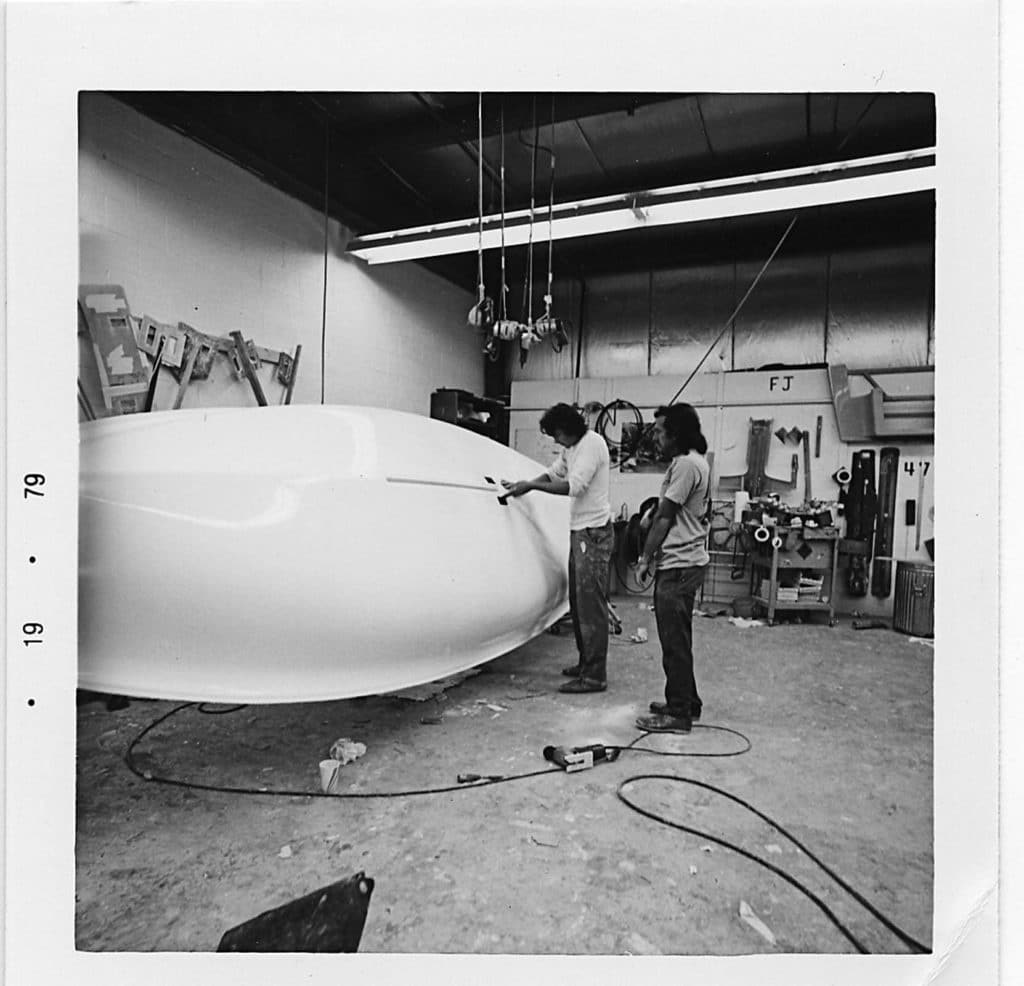
Vanguard also added the Finn, a class in which Peter and Olaf had been sailing. “It was built to specs provided by Jorg Bruder, who at the time was second only to the legendary Paul Elvstrom,” says Peter. “The problem was that nobody but Jorg could make the boat go.”
The boat was nicknamed Blue Dog because of its color and performance. Back to square one. “None of us were marine architects, but we knew the difference between the Newport Finn, with its very fine bow and fairly fine transom, and the Teal, which had kind of a medium bow,” Peter says. “The Teal was faster downwind, but upwind, the Newport was better. There wasn’t a boat out there that did both, so we decided to build one in between.
“We went on the theory that when a water molecule hits the front of the boat, it wants to go to the back of the boat in as straight and as short a line as possible. We had the boat upside down and just started looking at all the waterlines, at the horizontal lines going all the way around. We started to sand and shape the lines to create the shortest distance, and we kept the transom as wide as we could, within the tolerances, and went to a fine bow because we knew that was good. And we came out with this hull, and lo and behold, the damn thing worked.”
“There was no question that their boats were put together better than anyone else’s,” says longtime Finn sailor Gus Miller. “[Being hands-on with the build] was the opportunity to customize it for your size, weight and the way you liked to handle the controls. And you could do that before the deck was put on the hull, giving you a chance to put deck fittings on exactly where you wanted them. It was a lot easier that way.”
“It was pretty cool because they let me come in there even though I didn’t know much about engineering or boatbuilding,” says three-time Finn Gold Cup winner Cam Lewis. “But I said, ‘How about we line the fibers up at 45-degree angles instead of going fore and aft?’ One of the places I looked at doing that was around the mast hole in the deck. I figured the energy and loads had to be more 45 degrees than they were fore-and-aft on the fibers. I don’t think anybody ever said no to anything I asked if it was at all possible.”
A little bribery didn’t hurt, either. “It seemed that the more Red White & Blue beer we bought, the harder they pushed on the rollers and squeezed out more resin,” says Lewis. “That was my theory, anyway.”
A unique sense of camaraderie developed between the workers and the sailors. “I was lucky in that, by that time, I had developed a fair amount of respect from them about being able to sail the boats pretty quickly,” says Benjamin. “They were looking to learn from me about what we needed in the boats to make them go as well as possible, and I was looking to them to learn how to build it, so there was a bit of synergy there.” The workforce, Taylor recalls, was a bunch of earnest, hard-working Midwesterners. “For the most part, we were a bunch of long-haired hippies with Eastern political views that were a lot different from those in Pewaukee,” he says.
The common ground was an unbridled desire to produce the world’s fastest Olympic dinghies, and that desire was fostered in large part by the Harken brothers’ leadership. “The shop had the highest morale of any shop I’ve ever seen,” says Miller. There were winter Hawaiian parties, usually held once the temperature dropped below zero. Ground-up cornhusks used in the tumbler for aluminum and stainless-steel parts were spread on the floor like beach sand, and the thermostat was jacked up to 85 degrees. There was usually live music as well, featuring the company rock band, which was allowed to practice at Vanguard during off-hours. The band went through several iterations and names, the most notable of which was Big Stink and the Smell, a name originating from the long-lasting odor of polyester resin. “I played guitar,” says Cucchiaro, “and they let me join in. After work, we’d practice every night, and we played at the Christmas party.”
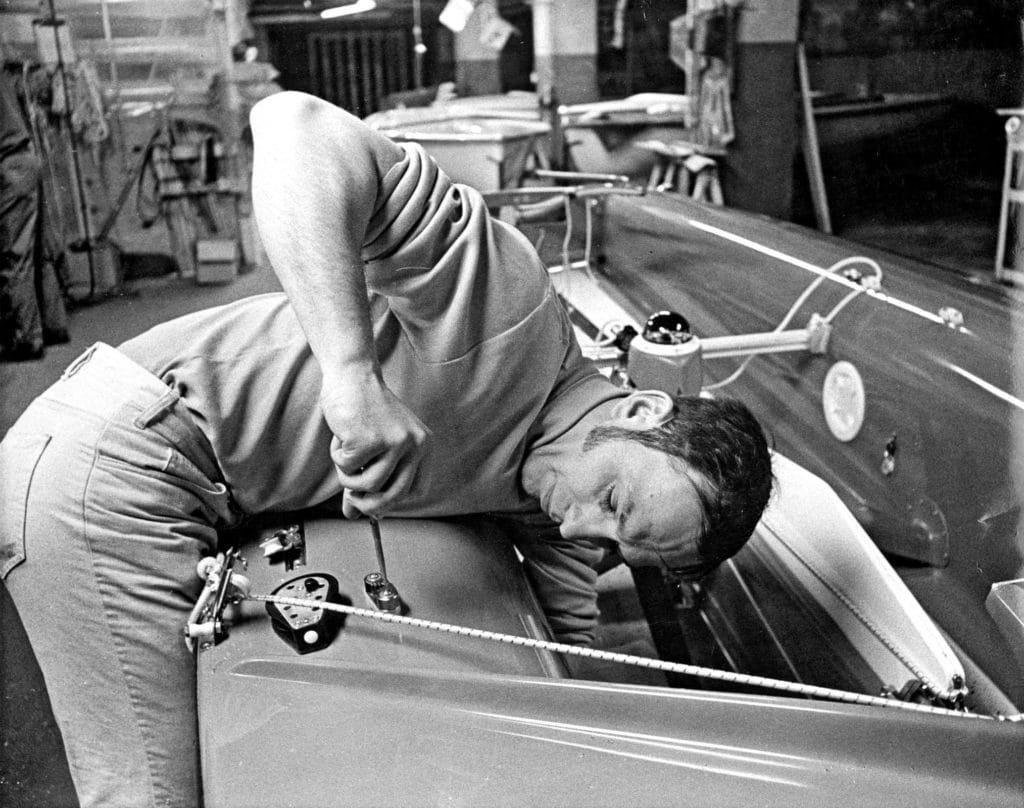
Then there was a Pepsi machine filled with beer. “At the end of the day, we’d gather around that machine and drink that damn thing dry,” says Peter. “Of course,” he adds with a laugh, “we can’t do that sort of thing today.”
Toward the end of the 1970s, two very sophisticated, first-of-their-kind carbon, Kevlar and epoxy Flying Dutchman hulls for Taylor and Loeb were built at Vanguard in preparation for the 1980 Olympics. “We wanted to cook the boats,” says Taylor. “So Peter personally helped us modify one of his buildings to create an oven so air would blow down into sheets of Styrofoam that we had built as a box around the mold, so we’d have an oven to heat the boat in after we laid it up.”
It was a big risk for Vanguard, as the boats were so stiff that there was a risk they would ruin the molds. “At first, we couldn’t get [the boat] out,” recalls Loeb. “But Bob and Donny worked slowly around the edges, and after about a half-hour, they got it to pop.” Each hull shell—20 feet long—weighed only 71 pounds, and in a testament to the careful monitoring of materials, the hulls were only 2 ounces apart.
Then came the American boycott of the 1980 Games, and although the FDs did quite well in international competition, neither boat ever saw an Olympic starting line. The effect of the boycott also rippled through the 470 and Finn classes, and many who had been working for an Olympic berth in those boats folded up their tents, some moving on to other classes and others abandoning competitive sailing altogether. By the early 1980s, Vanguard 470s were no longer the boat of choice, being replaced by boats made overseas. After having built nearly 1,100 Finns and 1,500 470s, Vanguard made one last Olympic-class surge, supplying all the Finns for the 1984 Games in Los Angeles. In the second half of the 1980s, the U.S.-made Finn suffered the same fate as the 470. The last Vanguard Finn was built in 1984 and now resides, fully rigged, in the Harken company lobby.
Over the next decade, Vanguard focused on Optimist dinghies, Club 420s, Flying Juniors, two different Gary Hoyt-designed pedal boats, MIT Tech dinghies and the Volant, which Harken’s John Schiefelbein, a former Vanguard employee, describes as “basically a Flying Dutchman with the back end chopped off.”
Pewaukee production ended in the spring of 1986, when the company, along with the name, was sold and moved to Rhode Island. “Our hardware company had really established itself,” says Peter, “and it was getting to be too much doing the hardware and the boats. Plus, we were getting tired of always fighting, not with the IYRU, but over in Europe, [where] they were constantly trying to make our boats illegal. I think they were just pissed off that this goddamn builder in the middle of corn country should be beating them.”









